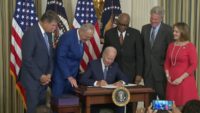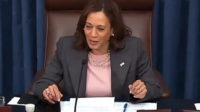Democrats in the House of Representatives pushed through a sweeping climate, health care and tax package that includes billions of dollars in tax incentives and authorized funding for projects set to reduce greenhouse gas emissions across the U.S. economy.
The Aug. 12 vote was strictly along partly lines, with 220 Democrats voting in favor of the bill and 207 Republicans against it.
The bulk of the nearly $700-billion package is $369 billion in funding and tax-credit extensions aimed at reducing carbon emissions through a broad range of projects in energy, transportation, water, buildings and manufacturing sectors.
House Speaker Nancy Pelosi (D-Calif.) said that the measure, the Inflation Reduction Act, is “historic, transformative and cause for celebration,” in a press briefing hours before the vote. The House action represents final congressional approval of the legislation, with the Senate clearing it Aug 7. The bill now is set for President Joe Biden’s expected signature.
Dennis Truax, president of the American Society of Civil Engineers, which last year recommended energy-policy steps in areas such as carbon reduction, renewable energy, distributed generation and affordable rates, said the bill “addresses these recommendations at a never-before-seen scale, providing additional funding to develop transmission lines to connect to new sources of renewable energy.”
The bill would "close about two-thirds of the remaining emissions gap between current policy and the nation’s 2030 climate target, 50% below 2005," says a detailed analysis led by Princeton University's Andlinger Center for Energy + the Environment and Dartmouth College's Thayer School of Engineering.
Nearly $3.5 trillion in cumulative capital investment in new U.S. energy supply infrastructure between 2023 and 2032 would also result. Researchers indicate impact predictions have some uncertainty.
Provisions in the measure dealing with labor requirements drew praise from construction unions but criticism from some major contractor groups.
Among the bill's many climate components are provisions to extend federal tax credits to spur solar, wind and other renewable energy projects, an expansion and extension of the 45Q credit for carbon capture, utilization and storage (CCUS) and direct air-capture projects favored by industry, a credit to keep nuclear power plants operating, and tax credits that could make renewable power-generated green hydrogen projects cost-competitive with those fired by coal or gas.
The construction start deadline for carbon capture, direct air capture, or carbon utilization projects will extend seven years to December 31, 2033, and 45Q per-ton credit values for industrial and power generation projects will increase.
For the first time, energy storage projects would also qualify for an investment tax credit. The bill also creates separate production tax credits for battery deployment and encourages domestic battery production and processing of critical minerals in the battery supply chain.
Tom Kuhn, president of the Edison Electric Institute, which represents electric utilities, called the clean energy tax credit provisions “the right policies,” adding that “this legislation firmly places the U.S. at the forefront of global efforts to drive down carbon emissions, especially when paired with the historic [research, design, development and demonstration] funding included in the bipartisan infrastructure law.”
The American Institute of Architects points to several important provisions it successfully lobbied for that deal with energy efficiency in buildings, including $330 million in grants to states and localities to adopt energy codes that at least meet the 2021 International Energy Conservation Code, or ASHRAE 90.1-2019.
AIA said the measure also authorizes $670 million for states and localities to adopt and carry out zero-energy “stretch” codes.
In addition, the bill has $215 million for the U.S. General Services Administration to carry out retrofits of federal buildings, plus $2.15 billion for the Federal Buildings Fund that the agency can use to install low-embodied carbon materials and products in federal building construction or renovation, according to AIA. There also are energy-efficiency provisions targeted for the residential sector.
“Though the climate crisis still requires our unrelenting attention, this legislation is a step in the right direction,” said Lakisha Ann Woods, AIA's CEO.
While enactment of the bill, in addition to the Infrastructure Investment and Jobs Act last year and the just-signed CHIPS Act, will infuse unprecedented levels of funding into decarbonization projects, that step is just the beginning of a lengthy process to get funds into the hands of project developers, Brian Ross, vice president of renewable energy at the Great Plains Institute, said in an interview with ENR.
“There’s a whole kind of regulatory infrastructure that has to be built up to be able to walk this funding into a realm where it is successful,” Ross said. “It’s going to take time to build the up that infrastructure, and make sure that business models within industry are in place to be able to take advantage of it.”
Split Views on Labor Provisions
An analysis by the Labor Energy Partnership, a joint project of the Energy Futures Initiative and the AFL-CIO, says the Inflation Reduction Act could add 1.5 million jobs and $250 billion to the economy by 2030, and decrease overall energy consumption.
The bill “tackles climate change while also taking a common sense approach to our energy needs rather than setting unrealistic goals for an abrupt energy transition," said Terry O’Sullivan, general president of the Laborers' International Union of North America, in a statement. “The legislation invests in efficiency and innovation for all fuel types—from hydrogen, nuclear, renewables, fossil fuels to energy storage, and with inclusion of Davis-Bacon and apprenticeship language which is important in ensuring that the jobs created are good union jobs.”
But some construction groups—including the Associated Builders and Contractors and the Associated General Contractors of America—chafe at the pro-labor provisions.
AGC said in a newsletter that the measure for the first time sets Davis-Bacon prevailing-wage and registered apprenticeship requirements as conditions for receiving tax breaks for clean energy projects and energy-efficient commercial buildings, under Section 179D of the tax code, with some "limited exceptions."
Kristen Swearingen, ABC vice president of legislative and political affairs, said in a statement, “This unprecedented expansion of prevailing wages not only puts contractors that use industry-recognized apprenticeships at a serious disadvantage when it comes to winning contracts for these critical energy projects, but it also limits the ability of many otherwise-qualified small businesses and skilled construction professionals from participating in these projects.”
The legislation also contains health care provisions to expand Medicare benefits and lower prescription drug costs.
The bill’s chief Senate sponsors—Majority Leader Charles Schumer (D-N.Y.) and Joe Manchin, (D-W.Va.), say the bill could reduce greenhouse gas emissions 40% by 2030.
The bill includes some concessions to Manchin, who surprised much of official Washington by negotiating a deal with Schumer a little over a week before lawmakers were to begin their long August recess.
These include a commitment to enact permitting reforms for construction projects by the end of September and $4 billion for emission retrofits or CCUS installations at coal-fired power plants.







Post a comment to this article
Report Abusive Comment